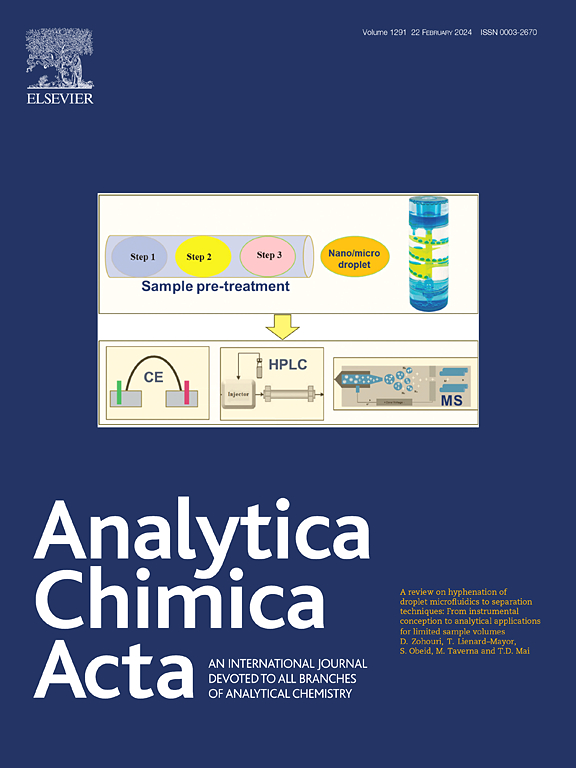Analytical quality control in targeted lipidomics: Evaluating the performance of commercial plasma as a surrogate for pooled study samples
IF 5.7
2区 化学
Q1 CHEMISTRY, ANALYTICAL
引用次数: 0
Abstract
Background
Pooled quality control (PQC) samples are the gold standard for data quality monitoring in metabolic phenotyping studies. Typically composed of equal parts from all study samples, PQCs can be challenging to generate in large cohorts or when sample volumes are low. As an alternative, externally sourced matrix-matched surrogate QCs (sQC) have been proposed. This study evaluates the performance of sQCs against PQCs for assessing analytical variation, data pre-processing, and downstream data analysis in a targeted lipidomics workflow.
Results
Plasma samples (n = 701) from the Microbiome Understanding in Maternity Study, along with PQC (n = 80) and sQC (n = 80) samples, were analyzed using a lipidomics assay targeting 1162 lipids. QC samples were injected throughout acquisition, and data pre-processing was performed using each strategy. For simplicity, a subset (n = 381) of the study samples was used to assess differences in downstream statistical analyses.
Both QC approaches demonstrated high analytical repeatability. While PQC and sQC compositions differed, use of PQCs retained less than 4 % more lipid species during pre-processing. Univariate analysis identified more statistically significant lipids with PQC-based pre-processing, but multivariate model performance was similar between datasets.
Significance
This study provides a comprehensive comparison of QC strategies and emphasizes the importance of careful QC workflow selection. While PQCs offer advantages, sQCs serve as a suitable alternative for quality assessment and pre-processing. Their commercial availability also supports use as intra- and inter-laboratory long-term references, aiding data harmonization across studies and laboratories.

靶向脂质组学的分析质量控制:评估商业血浆作为合并研究样本的替代品的性能
混合质量控制(PQC)样本是代谢表型研究中数据质量监测的金标准。pqc通常由来自所有研究样本的相同部分组成,在大型队列或样本量低的情况下,生成pqc可能具有挑战性。作为替代方案,已经提出了外部来源的矩阵匹配代理qc (sQC)。本研究在靶向脂质组学工作流程中评估sQCs与pqc在评估分析差异、数据预处理和下游数据分析方面的性能。结果使用针对1,162种脂质的脂质组学分析,分析了来自孕妇微生物组学研究的血浆样本(n = 701),以及PQC (n = 80)和sQC (n = 80)样本。在整个采集过程中注入QC样品,并使用每种策略进行数据预处理。为简单起见,研究样本的一个子集(n = 381)被用来评估下游统计分析的差异。两种QC方法均具有较高的分析重复性。虽然PQC和sQC组成不同,但在预处理过程中,PQC的使用保留了不到4%的脂质种类。单因素分析发现,基于pqc的预处理更具有统计学意义的脂质,但数据集之间的多因素模型性能相似。意义本研究对质量控制策略进行了全面的比较,并强调了仔细选择质量控制工作流程的重要性。虽然pqc具有优势,但sQCs作为质量评估和预处理的合适替代方案。它们的商业可用性也支持用作实验室内部和实验室间的长期参考,帮助研究和实验室之间的数据协调。
本文章由计算机程序翻译,如有差异,请以英文原文为准。
求助全文
约1分钟内获得全文
求助全文
来源期刊

Analytica Chimica Acta
化学-分析化学
CiteScore
10.40
自引率
6.50%
发文量
1081
审稿时长
38 days
期刊介绍:
Analytica Chimica Acta has an open access mirror journal Analytica Chimica Acta: X, sharing the same aims and scope, editorial team, submission system and rigorous peer review.
Analytica Chimica Acta provides a forum for the rapid publication of original research, and critical, comprehensive reviews dealing with all aspects of fundamental and applied modern analytical chemistry. The journal welcomes the submission of research papers which report studies concerning the development of new and significant analytical methodologies. In determining the suitability of submitted articles for publication, particular scrutiny will be placed on the degree of novelty and impact of the research and the extent to which it adds to the existing body of knowledge in analytical chemistry.
 求助内容:
求助内容: 应助结果提醒方式:
应助结果提醒方式:


